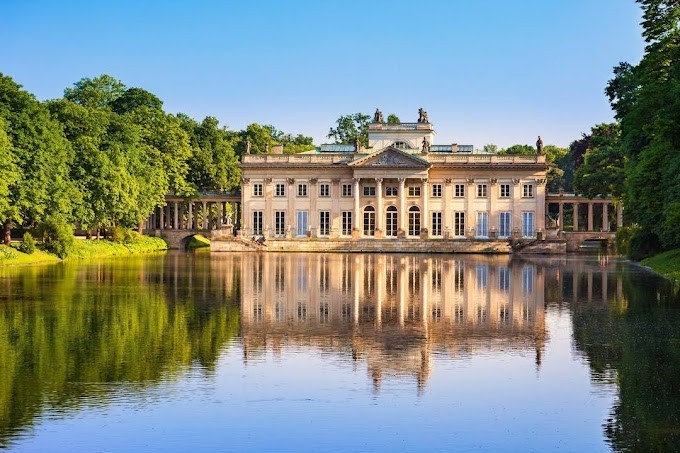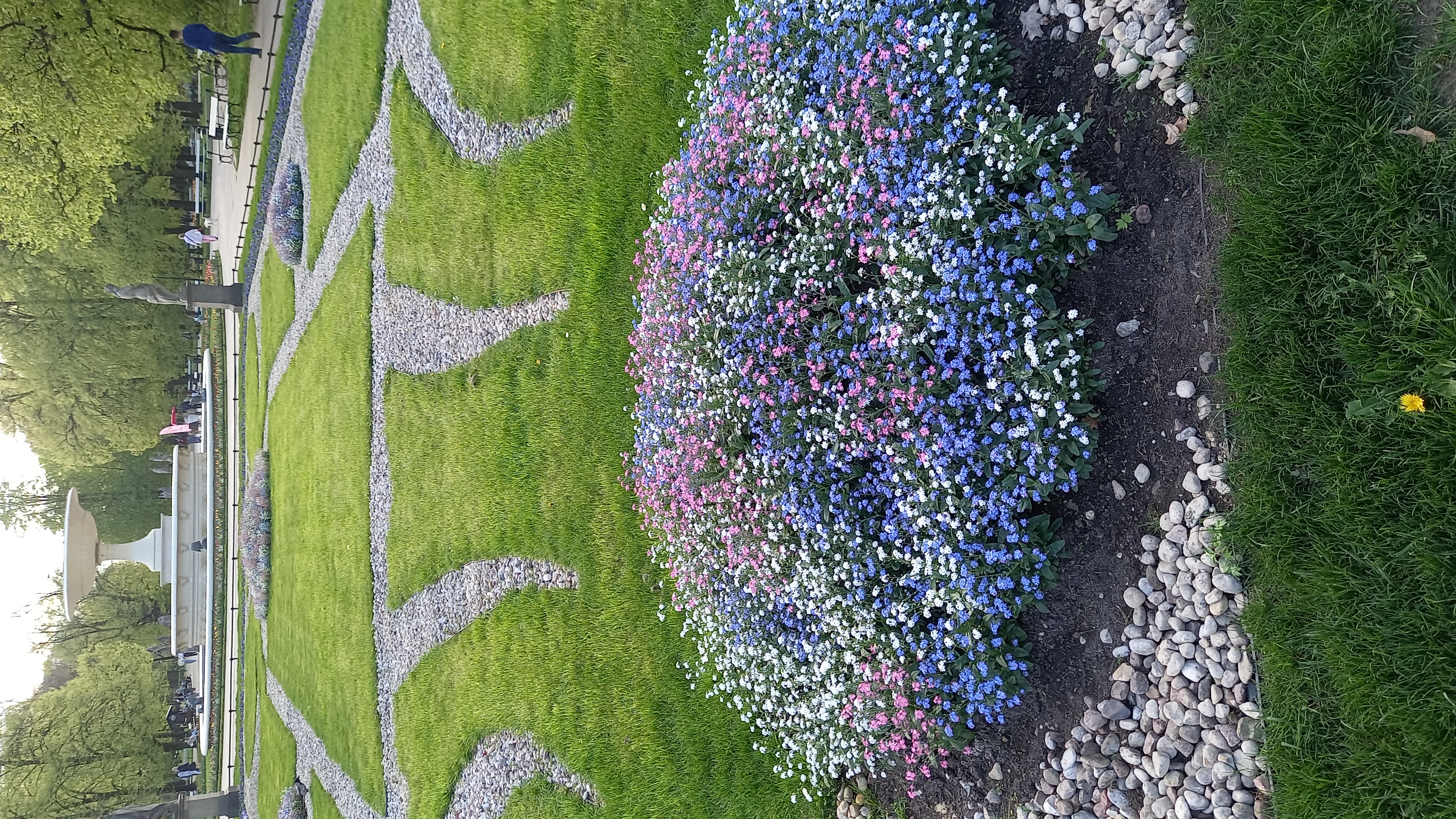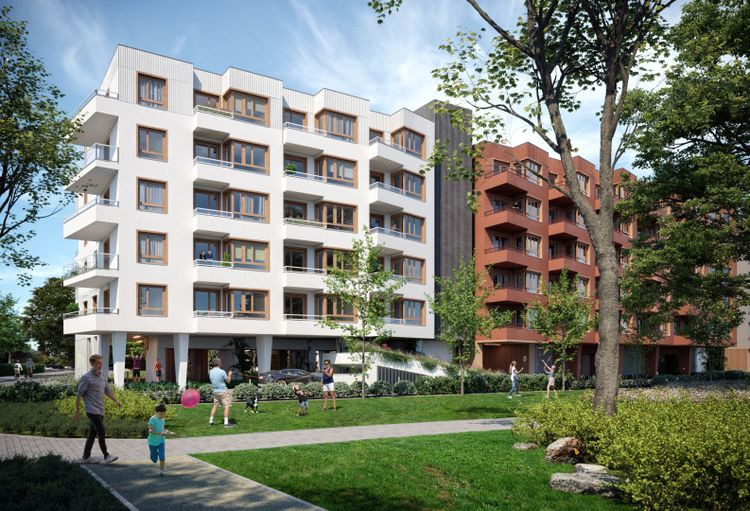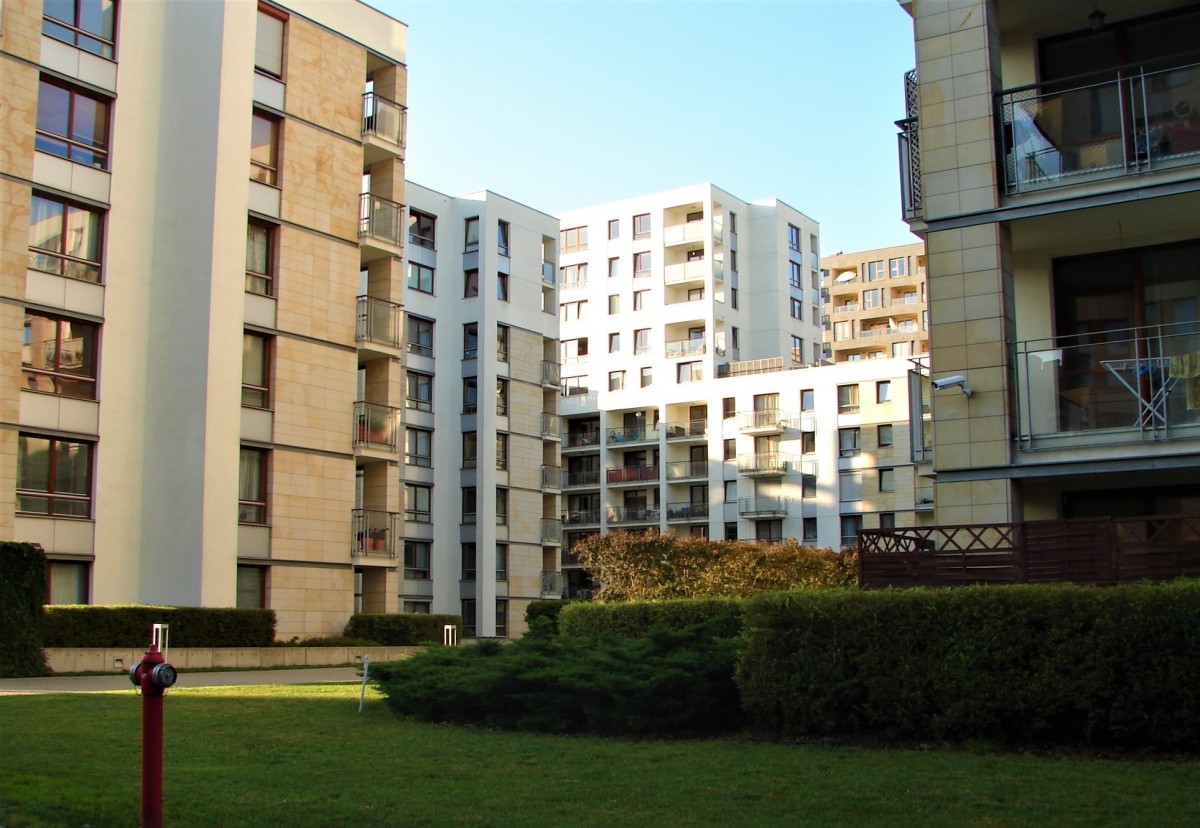Mokotów. Microdistrict (obszar) „Sielce” (Sielce)

Mokotow. Microdistrict (obszar) „Sielce” (Sielce)
The boundaries of the Sielce microdistrict are determined as follows:
Streets Nowosielecka, Podchorążych, Gagarina, Spacerowa (along the border of the districts Śródmieście/Mokotów) - crown Skarpy Warszawskiej in a southerly direction to the street. Dolnej, across the eastern border of Skweru Małkowskich, eastern border of Warszawianki, crossing the street. Zywnego and Al. Giżyckiego to the height of Królikarni-Idzikowskiego-Witosa-Czerniakowska.
History of the Sielce neighborhood
First mentioned in 1412. Sielce was a village on the left bank of the Vistula, not far from the passage from Kamion, guarded by a castle in Jazdów. It was probably founded in the 12th century along the river road leading from the Tamkin slope and gorge to the pier. Barges with goods arrived here, sailing along the Vistula from south to north. Among many other goods, salt from Wieliczka was transported by water, and salt warehouses were located on the banks of the river. The name of the village Solec comes from the Polish word for “from salt”, and the road along the river was originally called Szoletska.
Since the 14th century, the lands of Sielce belonged to Old Warsaw. The village was threatened by frequent floods. Before the 15th century, the course of the often changing river course tore away part of the Sielca, creating Solec Kepa, later to become Saska Kepa, and probably flooded some dwellings. However, the village grew and gradually turned into a suburb. In 1675, the Soletsk Legal Chamber was formed. Craftsmen, merchants, those who worked on river transport, and nobility lived here. At the turn of the 18th century, a Trinitarian church and monastery were built. At the beginning of the 18th century, 5,000 people lived here.
Eleven streets were founded, including Solec, Czerniakowska, Okrag, Smolna, Rozbrat and Sarah, which still exist today, as well as Gurna, Naprawa, Przypust, Karpia and Mienczna, which disappeared without a trace. At the Solec market there was a wooden town hall, and nearby there was a salt warehouse. There were small industrial establishments here, including ten starch factories, two soap and candle factories, eight breweries, numerous workshops, as well as 61 taverns and eight soup kitchens, some of which were dedicated to the rafters. In the second half of the 18th century, several mansions were built here for magnates, including the small Szymonowicz Palace and the palace of Kazimierz Poniatowski, the king's brother. At the end of the 18th century, Solec was legally incorporated into Warsaw. Around 1800, new salt warehouses were built between Solec and Okrag Street. Over time, other workshops were established, such as a brick factory and a tannery.
At the end of the 18th or beginning of the 19th century, the still existing Folwark Sielce was created in Sielcach, which is one of the most valuable monuments in Sielce.
In the first half of the 19th century, part of the territory of Sielc belonged to Grand Duke Constantine. The Sielce then became the property of the Russian state, to which they belonged until the restoration of Polish independence in 1918.
In the first half of the 19th century, the Sielce area had an industrial character. A steam engine factory, a steamship plant, a steam mill and a carpet factory were created. Sielce became a suburb densely populated by workers, merchants, administrators and Jews associated with the Vistula trade. At the beginning of the 20th century, Sielca's industry was focused on housing construction. After the Poniatowski Bridge was built, public buildings were built and the suburb acquired a more representative character.
In the second half of the 19th century, most of Sielc was intended for barracks, but the palace and Sielecki Park were a favorite place for out-of-town trips for Warsaw residents. The railroad came here in 1891.
Sielce became part of Warsaw in 1916. At the same time, the former Książęca street was named Chełmskiej, Łazienkowska - Nabielaka, Długa - Iwickiej, Ogrodowa - Czerskiej, Wspólna - Magnuszewskiej (then Gagarina), Okopowa - Podchorążych. These changes began the transformation of Sielc from a rural and resort environment to an urbanized and industrialized area.
During the interwar period, the western territories of Sielc in the area of Belwederskiej street gradually became a fashionable and elegant area of dolnego Mokotowa. This process was interrupted by the outbreak of World War II and the destruction caused by the ongoing fighting in Sielcach during the Warsaw Uprising.
Sights of the Sielce microdistrict
Parks in Sielce
There are many green areas for recreation and entertainment in the Sielce area.
- Zespół przyrodniczo-krajobrazowy Arkadia (Park Arkadia) - Natural landscape complex Arkadia (Arcadia Park)
The natural landscape complex “Arkadia” was created to protect the area changed by man, and is connected with the neighboring palace and park complex “Królikarnia”. The park is a natural phenomenon in Warsaw, a haven for rare species of animals and plants. The area periodically becomes swampy, and groundwater seeps from the slopes, creating valuable wetland biotopes. The park covers an area of 14 hectares.
The first park here was founded in the 17th century by Stanislav Lyubomirsky. Part of the park is located on the escarpment (Arkadia Górna), and part at its foot (Arkadia Dolna). Both parts of the park are connected by a system of stairs leading along the slope of the alley and a ravine, which is also the border of the park, at the entrance to which there is a children's playground. You can ride bicycles, skateboards and roller skates. You can often meet runners here.
The height of the slope in Arkadia Park is about 20 meters, and the slope is approximately 30-45 degrees. Natural water erosion processes predominate here. On the slope there are natural springs and seepages that feed three ponds located below, which determine the composition of the sub-escarpment of Arkadia. Currently, the park is formed by a picturesque arrangement of three ponds, including the ponds Pod Królikarnią and Staw Arkadia, connected by a canal. The canal also diverts excess water to the north. Rest areas and stone bridges were created around the ponds to allow crossing to the other side of the reservoir.
In the upper part of the park there are chestnut trees, Norway maples, ash maples, common elms and linden trees. Some of them are classified as natural monuments. In Arcadia there is a mixed-grass meadow and a group of more than century-old lindens, which are a natural monument. Arkadia Dolna used to be the floodplain of the Vistula, so old willows and poplars are also present here.
Here you can find more than 80 species of wild animals, including many protected ones. Arcadia's ponds are home to protected species of amphibians, including common and green frogs. Waterfowl such as mallards and coots are also found here. In total, several dozen species of birds live in Arcadia Park, including forest birds, which are very rare in the city center, such as tawny owls, middle and green woodpeckers.
- Promenada Park
In the Selce microdistrict there is the Promenada Park, which is connected by alleys to the Morskie Oko Park and the Szustrow Park in the neighboring territory. Promenade Park consists of two large ponds. These are old clay quarries, remnants of the development of Pliocene clays. They were once part of the garden created for Izabela Lubomirska, then they were part of the Promenada summer resort, created in 1845 by Franciszek Schuster. The garden around the ponds is landscaped. Folk games and open-air performances took place here. Today it is a quiet place loved by joggers and children - there is a playground.
- Morskie Oko Park
Created as part of a romantic garden designed for Princess Izabela Lubomirska, née Czartoryska. Since 1820, the estate began to belong to Anna Potocka, née Tyshkevich. This estate was called Mon coteau, or my hill. The park contains architectural monuments - the Szustra Palace, the Szustrów family tomb and the monument to Jan Matejko. The park is not fenced. There is a pond and a children's playground.
- Sielecki Park
This is a small park between the street. Sobieskiego and st. Chełmską, the remains of a former royal manor, consisting of a palace building, two outbuildings, a complex of outbuildings and an English-style garden. The most important objects are the pond and the islands. On this pond, both during the First and before the Second World War, it was possible to ride a boat. During the interwar period there was also an amusement park and playground. During the interwar period there was also an amusement park and playground. Currently there is only a play area and ping pong tables. Part of the former foundation, the Sielecki Palace (Pałac Sielecki), has survived to this day, but cannot be visited as it is a private building.
The palace with outbuildings and the remains of the garden have survived to this day. The park covers an area of 3.16 hectares. This is a green area surrounding ponds with islands (a quarter of the entire park area). The coastline is covered with large poplars. Together with the park path running along the shore, they form the main composition of the site. The area north of the ponds and along them on the eastern side is occupied by trees and shrubs (19th century). The site with the palace in the north-eastern part belongs to the Studio of Documentary and Fiction Films, and the park belongs to the State Treasury. The pond has a length of about 400 m and is fed with water from the Sieleckiego canal, flowing from the direction of the Piłsudski fort. There is a pedestrian bridge across the canal in the park. Park Alley passes through the bridge.
The most interesting objects of Sielc also include:
- Red Villa (willa Friedbergów) - historical apartment building on the street. Sułkowickiej, 3 in the Sielc microdistrict in the Mokotów region. The villa was built between 1925 and 1928 for the merchant Mikhail Fridberg. The architecture of the building is a striking example of Warsaw modernism. It owes its name to the Pompeian pink façade. The villa is included in the register of monuments.
- Palace in Sielce (Pałac Sielce), also called the Stanisława Augusta Bathhouse (Laknie Stanisława Augusta). Located at st. Zbyszka Cybulskiego, 3 and is used as the headquarters of the Polish Employers Association. Consists of a palace and two buildings belonging to it.
To the south of Warsaw was the rural village of Sielce. The northern part of this village was given in 1412 by the Polish king Janusz I the Elder to the Catholic Church (Collegiate College of St. John), in whose possession it remained until the third partition of Poland in 1795 and subsequent confiscation by the Prussian authorities. The second part of Selce was used as a royal estate (Selce farm).
Towards the end of the 18th century, the last Polish king, Stanisław II August Poniatowski, ordered the expansion of the nearby Belvedere complex on the site of the former estate. The building, which was supposedly used as a bathhouse, was laid out for him in the new park landscape. Around 1820, the complex belonged to the Russian prince Konstantin Pavlovich Romanov, who built a palace here with two side buildings (called pavilions).
The complex became the property of the Grand Duke thanks to the purchase of the Belvedere in 1818. The English-style landscaped park extended over 11 hectares. The Governor General used the palace as a summer residence. In 1831, the ensemble was bequeathed to the Grand Duke's younger brother, Tsar Nicholas I. In subsequent years, the palace was changed, mainly for commercial use and was not properly preserved.
In 1916, Selce was incorporated into Warsaw. In the medium term, this changed the structure of the area from rural to urban development. Part of the park was allocated for residential construction. The palace, which had fallen into disrepair over the years, was renovated by the city in 1918 and the remaining park was made available to the public.
The palace was designed in the classicism style of that time and is practically undecorated. The two-story building, built on a rectangular plan, has a central projection, each with a triangular pediment at the front and rear. On the east-facing façade, there is a small balcony supported by two columns above the entrance door. On the park side, in the 2000s, a flat extension was built on the site of a wooden winter garden. Two one-story symmetrical wings are located approximately 50 meters each from the palace. Behind the ensemble lie the remains (3.2 hectares) of the former landscaped garden, now known as Sielce Park. The barracks buildings originally located in front of the palace (i.e. to the east) no longer exist. Here are the offices and halls of the film company (Wytwórnia Filmów Dokumentalnych i Fabularnych), which were built after the Second World War.
During the war, the buildings were fought over during the Warsaw Uprising and were later destroyed. The park was also devastated at the end of the war. In addition to the palace with its two pavilions, which was rebuilt between 1945 and 1950, there is a 19th-century park pond that still exists today. A complete reconstruction was carried out in 1998. Since 2012, the palace has served as the seat of the Association of Polish Employers.
- Hospital Czerniakowski
- Monastic complex nazaretanek z kościołem św. Jozefa Oblubieńca
- The building of the Auto-Koncern car dealership, now rebuilt and turned over to the headquarters of the local police.
Historical residential complexes in Sielce
- Residential area Sielce
In 1952, construction began on the Sielce residential area, designed for approximately 6–10 thousand residents, located between Nowoparkową, Czerniakowską, Chełmską and Belwederską streets. The free space between the surviving buildings began to be filled with socialist realist (in some places stylized in the Baroque style of the 18th century) residential and public buildings. Work on the first two residential complexes was completed by 1957, and the third was built in the 1960s closer to the street. Czerniakowskiej (in the area of the former Wójtówki). During the same period, the residential complexes Dolna-Belwederska, Dolna-Piaseczyńska and Dolna-Sobieskiego were built. In 1974, Wisłostradę was opened, absorbing the street. Czerniakowską.
To date, the residential area has undergone minor transformations; some vacant areas have been built up with modern residential buildings and office buildings.
- Colonia Grottgera
This is an interwar residential complex located on the border of Morskie Oko and Promenada parks. The massive buildings placed in the facades were built for the intelligentsia of that time. Before World War II, the street was lined with factories. Zajonczkowska (the first Polish film cameras and radio stations were created here, parts for the Polish Enigmy were created). A secondary school was built.
The houses here are not scattered freely, but form compact facades along the apartment building. There are several types of buildings: classic apartment buildings in the center on the street. Grottgera 1-10 and buildings on the street side. Belwederskiej, long residential building on the street. Grottgera 12A, apartment buildings in the second development zone on the side of the Promenada park (Grottgera street 5A, 11A, 19A) and massive buildings of the colony proper (Grottgera street 13/15/17/19, 21/23/25, 12/14/ 16/18 and on Pogodnej street, 2/4/6).
The buildings are massive apartment buildings with distinctive triangular gables crowning the top floor and a facade decorated with avant-garde housing. The individual elements (houses) are quite clearly divided into segments. Each segment was decorated with pilasters and various external plaster structures. The top floor, cut off by a cordon cornice, is hidden behind a stylized attic pierced by windows.
The apartments have a comfortable design. These included storage spaces in the kitchen, niches for wardrobes and large windows between the kitchen and bathroom, which were supposed to illuminate it. There were also large basements, several meters long, but without balconies or central heating. Initially, apartments were heated with coal, so there were chimneys above the buildings. Many original elements have been preserved in the houses: handrails on the staircase, part of the front door, wooden pine floors in the apartments, doors and tiled stoves (there is no central heating in the building). The buildings also had mezzanines.
The colony is included in the register of monuments.
Despite numerous urban changes, many ancient buildings have survived to this day in Sielcę, in particular the villas in the area of \u200b\u200bthe street. Sułkovickiej and st. Nabielaka, as well as apartment buildings and post-war buildings. The buildings of the Russian Embassy and Uniwersus are also considered interesting post-war projects.
Modern residential complexes in Sielce
Residential complex Rezydencja Morskie Oko
The luxury residential complex Rezydencja Morskie Oko was built in 2005 and offers apartment owners all the amenities of a real apartment building:
- a cozy home,
- fenced area,
- spacious entrance hall with reception,
- spa area: swimming pool, fitness / gym, sauna,
- underground garage,
- silent elevators,
- storage rooms,
- beautifully landscaped and well-kept courtyard.
The Morskie Oko residence is one of the most attractive investments in Warsaw. One of the best places to live in the city. A quiet corner of Mokotów, adjacent to the park complex, which includes: Park Promenada, Park Szustrów and Park Morskie Oko, where you can fully relax from the bustle of the city. Łazienek Królewskich Park is a 10-minute walk away. The Palace of Culture and Science (Pałacu Kultury i Nauki) is 3.5 kilometers away - access in less than 10 minutes.
Near the residential complex there is the restaurant "Różana Restaurant", the sports center Warszawianka (Klub Sportowy Warszawianka), the Iluzjon Cinema, the Center for Contemporary Art (Centrum Sztuki Współczesnej). Numerous green areas, ideal for morning workouts and walks with the family. There are numerous kindergartens, schools, and universities in the area. Convenient and quick access to international schools in Sadybie (French and British) and Wilanowie (American and German).
Excellent transport links - proximity to bus stops, tram lines, metro stations. Chopin Airport is just 15 minutes away by car. Very convenient connections to any part of the city and the southern bypass of Warsaw (Południową Obwodnicą Warszawy).
Residential complex Nova Dolna
Nova Dolna is an investment located in Warsaw's Mokotowie at Piaseczyńskiej 51. Residents are provided with a high quality living space that provides comfort and, at the same time, functionality, adapted to today's standards and expectations.
The complex is located surrounded by Arkadia Park and in close proximity to Morskie Oko Park. Nova Dolna is a small investment, with only 32 apartments. Each of them has a height of 3 m and large, panoramic, aluminum windows. In addition, each apartment has a large finished terrace, air conditioning and ducted heaters.
The facade of the apartment building is made of natural stone, and the lobby and corridors are decorated with natural high-quality materials: stone, wood and leather. Reception with concierge. From Novej Dolnej Belwederską to the very center of Warsaw is just 8 minutes by car.
Investment Kierbedzia 4
Security: 24-hour security and access control, monitoring, fenced area, reception
Equipment and energy: air conditioning, electric vehicle charging point, bicycle room, glass elevator with views of the surrounding area
Number of storeys: the building has 8 above-ground floors, including a ground floor and 2 underground floors.
Number of apartments: the entire investment consists of 128 residential units, 1 multi-family residential building
Room height: depending on the floor, from 269 to 303 cm in height
Finish standard: builder's condition
Type of property: detached property with land ownership
Parking spaces: underground parking spaces (152 spaces) are provided for each apartment, the possibility of purchasing two
Start of construction – 3 sq. 2023, planned commissioning - 2 quarters. 2025
Eco solutions. Thanks to LED lighting of the investment area, energy consumption is reduced. For environmentally friendly modes of transport, access to car charging stations is provided. Organized recycling of rainwater for aquatic plants.
Comfort. Kierbedzia 4 are apartments with a thoughtful layout ranging from 34 to 90 sq. m. m, designed with everyday comfort in mind. For those who like small spaces, studios with a separate bedroom have been prepared to guarantee privacy for residents. The apartments have terraces, spacious balconies and garden plots, which are secluded places to relax. Thanks to panoramic windows, the interiors are bright and cozy.
Location. Dolny Mokotów is a prestigious address and a safe investment, close to Łazienek Królewskich, to the Morskie Oko park.
Communication. Ideal transport links, extensive network of transport links. The nearest metro point - Wierzbno - is 2170 meters from the Kierbedzia 4 investment.
Education. There are 29 educational institutions in the immediate vicinity of the Kierbedzia 4 investment. Nearest: kindergarten 160 m, primary school 170 m, school 210 m.
Health care. Access to medical care will be provided nearby: LuxMed Medical Center 180 m, Olinek Intensive Care Center 190 m, medical clinic 330 m.
Commercial and service infrastructure. Lots of points. Nearby, 50 m away is Żabka, 110 m away is Żabka, 220 m away is another Żabka.
Sport. In the immediate vicinity of the Kierbedzia 4 investment there are 3 fields/courts within 200 m.
Nature. Near the investment there are 5 parks and a lake.
Investment Dom Hygge Twin
Address: ul. Bobrowiecka 4B , Sielce, Mokotów, Warszawa
The start of construction is the 1st quarter of 2024, the planned commissioning is the 4th quarter of 2025.
Type of property: detached property with land ownership
The entire investment consists of one apartment building with 63 apartments. The building has 6 above-ground floors, including a ground floor and 2 underground floors. New apartments have different sizes. Among them there are apartments suitable for large families with children, as well as studio apartments and two-room apartments designed for 1-2 people. There are 63 apartments to choose from ranging from 27 m2 to 90.5 m2. On all floors the height of the premises is 275 cm. Elevator. Additional surfaces: balcony, loggia. Finish standard: builder standard
The apartments are finished at the highest level - each apartment includes, among other things: wooden windows; spacious, professionally decorated interiors; security – video surveillance is installed at the facility; functional environment - access to a two-level underground parking lot, proximity to commercial premises allowing the provision of basic services. Surface parking spaces are available.
Transport. Residents of the Dom Hygge Twin investment complex will be able to take advantage of an extensive network of transport links. The nearest metro point - Wierzbno - is 2260 meters from the Dom Hygge Twin investment. Tram - 1600 m, bus - 70 m.
Within 1 km from the investment there are: 4 medical institutions, 25 educational institutions, 22 cafes and restaurants, 34 shops, 24 sports facilities, 16 children's playgrounds.
Education. There are 25 educational institutions in the immediate vicinity of the Dom Hygge Twin investment. Nearest: kindergarten 290 m, primary school 330 m, school 360 m.
Health care. Access to medical care will be provided: LuxMed Medical Center 110 m, Olinek Intensive Care Center 400 m, Medical Clinic 530 m.
Shops and services. Nearby, 60 m away is Żabka, 240 m away is another Żabka, 270 m away is SPC.
Sports and nature. There are 3 fields/courts in the immediate vicinity of the Dom Hygge Twin investment. Nature in the area: 5 parks.
Social sphere in Sielce
In addition to the parks that we talked about above, other aspects of the social sphere are developed in Selts.
In the Seltse microdistrict there are municipal kindergartens and primary schools, as well as lyceums. On Bobrowieckiej Street there is the Warsaw Medical University. Tadeusza Koźluka, and on Chełmskiej Street - the Higher School named after. Bogdana Jańskiego.
Everything is fine with medical care. There is a primary care clinic on Iwickiej Street. There are also numerous private medical centers and specialized medical practices. Among them is the LUX MED clinic.
Sports enthusiasts living in the Sielce area have excellent conditions for running in numerous parks, as well as cycling - there is a good network of bicycle paths, including a route to the Vistula embankment. The Warszawianka Fencing Club and the Warszawianka Tennis Courts are located on PIaseczyńskiej Street. There are also sports and fitness clubs. The Zdrofit fitness club is located on Bobrowieckiej Street.
Transport services in the Seltse microdistrict are very good. The main streets - Belwederską and Czerniakowską - have many bus lines that go to different parts of Warsaw. Getting around by car is also easy, but the streets can get busy during rush hours.
Shopping in the Selce neighborhood can be done in many local grocery stores and popular chain stores (Netto, Lidl, Biedronka). You can dine in numerous cafes and restaurants.
The Panorama shopping center is located on Wincentego Witosa Avenue. The Panorama shopping center is considered the first real shopping center in Warsaw (and possibly in Poland), which was created in the 90s of the 20th century. It was a symbol of luxury, it had the first glass panoramic elevator in Poland, a fountain was installed in the atrium, and the corridors were lined with granite and marble. It was also profiled for luxury brands (and still is).
The building has a projection of an incomplete obtuse triangle and five office floors (four retail floors). The parking lots can accommodate 350 cars. There is no underground parking. The building has five entrances, two of which are adapted for people with disabilities. The building performs an office, retail and service function. The total area of the premises is 27 thousand m2, including a usable area of 22 thousand m2, and an office area of 2.3 thousand m2.
The first panoramic glass tube elevator in Poland was built here. The gallery offers three levels containing more than 90 luxurious retail spaces. These are car dealerships (Jaguar, Bentley, Ferrari, Maserati), perfumes, exclusive beauty salons, designer studios with interiors and household appliances, decorators, art galleries, antique stores and auction houses. There is also a gym, a grocery store and a cafe, and part of the office space is occupied by Bank Pekao. Due to profiling, the center is not very popular, being a place for people who value the uniqueness of products and the comfort of shopping.
Sielce is a beautiful area with many parks and a developed social sphere. This is a very comfortable place to live.
Blog


Prices for building materials in Poland in December 2023
Prices for building materials in Poland in December 2023

Mokotow. Microdistrict (obszar) „Służewiec” (Sluzhevets)
Mokotow. Microdistrict (obszar) „Służewiec” (Sluzhevets)





